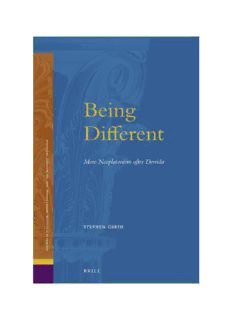
Being Different: More Neoplatonism after Derrida PDF
Preview Being Different: More Neoplatonism after Derrida
Being Different Ancient Mediterranean and Medieval Texts and Contexts Editors RobertM.Berchman JacobNeusner Studies in Platonism, Neoplatonism, and the Platonic Tradition Editedby RobertM.Berchman DowlingCollegeandBardCollege JohnF.Finamore UniversityofIowa EditorialBoard JOHNDILLON(TrinityCollege,Dublin)–GARYGURTLER(BostonCollege) JEAN-MARCNARBONNE(LavalUniversity,Canada) VOLUME16 Thetitlespublishedinthisseriesarelistedatbrill.com/spnp Being Different More Neoplatonism after Derrida By StephenGersh LEIDEN•BOSTON 2014 LibraryofCongressCataloging-in-PublicationData Gersh,Stephen. Beingdifferent:moreNeoplatonismafterDerrida/byStephenGersh. pagescm.–(AncientMediterraneanandmedievaltextsandcontexts) (StudiesinPlatonism,Neoplatonism,andthePlatonictradition,ISSN1871-188X;VOLUME16) Includesbibliographicalreferencesandindex. ISBN978-90-04-26140-2(hardback:alk.paper)–ISBN978-90-04-26164-8(e-book:alk.paper) 1.Neoplatonism.2.Derrida,Jacques.I.Title. B517.G4852013 141'.2–dc23 2013034217 Thispublicationhasbeentypesetinthemultilingual“Brill”typeface.Withover5,100 characterscoveringLatin,IPA,Greek,andCyrillic,thistypefaceisespeciallysuitablefor useinthehumanities.Formoreinformation,pleaseseewww.brill.com/brill-typeface. ISSN1871-188X ISBN978-90-04-26140-2(hardback) ISBN978-90-04-26164-8(e-book) Copyright2014byKoninklijkeBrillNV,Leiden,TheNetherlands. KoninklijkeBrillNVincorporatestheimprintsBrill,GlobalOriental,HoteiPublishing, IDCPublishersandMartinusNijhoffPublishers. Allrightsreserved.Nopartofthispublicationmaybereproduced,translated,storedin aretrievalsystem,ortransmittedinanyformorbyanymeans,electronic,mechanical, photocopying,recordingorotherwise,withoutpriorwrittenpermissionfromthepublisher. AuthorizationtophotocopyitemsforinternalorpersonaluseisgrantedbyKoninklijkeBrillNV providedthattheappropriatefeesarepaiddirectlytoTheCopyrightClearanceCenter, 222RosewoodDrive,Suite910,Danvers,MA01923,USA. Feesaresubjecttochange. Thisbookisprintedonacid-freepaper. CONTENTS Preface.................................................................. vii Acknowledgements..................................................... xv 1 NeoplatonicCompulsions Augustine........................................................... 1 2 Derrida’sParadigmsofNegativeTheology.......................... 29 2.1 BridgingtheGap Proclus ......................................................... 31 2.2 Prayer(s) Pseudo-Dionysius............................................... 75 2.3 HearingVoices MeisterEckhart................................................. 97 2.4 FromtheOnetotheBlank Damascius...................................................... 115 3 Philosophy[Space]Literature Proclus—Mallarmé................................................. 169 Bibliography ............................................................ 225 IndexofNames ......................................................... 243 IndexofTermsandConcepts........................................... 246 PREFACE ThisbookisaboutBeingbecauseitdealswiththeNeoplatonistswhowrite about “being” (toon). It is about Difference because it deals with Derrida whowritesabout“difference”(différence).ItisaboutBeingandDifference becauseitdealswiththeNeoplatonistsandalsowithDerrida. BeingDifferent.MoreNeoplatonismafterDerridaisthetitleofthesecond part of a project begun around 2000 of which the first part was entitled NeoplatonismafterDerrida.Parallelogramsandwaspublishedin2006.1The reasons for embarking on such a project were explained in the preface to the earlier volume and, apart from mentioning that a certain crisis in traditional metaphysics and the response of various modern readers of Neoplatonismtothatcrisishadgiventhebroaderprojectitsinitialimpetus, wewillnotrestatethoseargumentsindetailatthispoint.However,itmay be useful to clarify the nature of the project a little further in the light ofmisunderstandings that seem tohaveoccurredin theminds of certain readersoftheearlierbook. Aboveall,itisnecessarytograspthesignificanceofthephrase“Neopla- tonismafterDerrida”thatwasthetitleofthefirstvolumeandisthesubtitle of the second. The project was not labelled “Derrida after Neoplatonism” becauseitwasnotprimarilyconcernedwithDerrida’sresponsetoNeopla- tonismortheinfluenceofNeoplatonismuponDerrida:topicsadmittedlyof someinterestbecauseDerridaisoneofthefewmodernthinkerswhohave made the effort to comprehend this tradition historically and creatively. The project was labelled “Neoplatonism after Derrida” in order to under- linethefactthat,inconsideringtherelationbetweenNeoplatonicthought andDerrida’swriting,thepossibilityofNeoplatonism’sfutureenrichment by an encounter with deconstruction is the paramount issue. Despite its commitmenttowhateverismetaphysicallyprior,stable,andtimeless,the thinkingtowhichthelabel“Neo-platonism”hasbeenattachedduringthe 1 StephenGersh,NeoplatonismafterDerrida.Parallelograms(Leiden:Brill,2006).For ananalysisofthisvolumeseethevaluablestudyofD.GregoryMacIsaac,“PlatonicDecon- struction.AReviewEssayofStephenGersh’sNeoplatonismafterDerrida.Parallelograms,”in Dionysius27(2009),pp.199–225. viii preface last one hundred and fifty years has always been an evolving tradition.2 WhenPlotinusturnedtowardsthephilosophyofPlatohepenetratedtoits depthsbutalsochangeditradically.Augustinetookthetransformedlegacy ofPlato—whichwasbynowaPlatonism(orreallyaNeo-Platonism)—and madeitChristian.MarsilioFicinousedasynthesisofthePlotinianadAugus- tinianversionstoinitiateanewstyleofthinkingthatbecameanauthorita- tivecommentaryonPlatohimself.Moreover,thephilosophiesofPlotinus, Augustine,andFicinosimplyrepresentthreeofthemainstagesofanevolv- ing tradition that contains many subordinate phases, many interruptions and reprises, and many deviations. There have also been related and par- alleltraditionsofthinkingthat,althoughtheyarenotnormallydescribed withtheterm“Neoplatonism”sharemanyofthattradition’sphilosophical assumptions.ThisisparticularlytruewithrespecttoGermanyinthelate eighteenth and early nineteenth centuries and to European Romanticism moregenerally.ThereappearanceofNeoplatonicconceptsorthemescan thusbenotedinobviousplacessuchastheobjectiveIdealismofHegelorin boththeearlierandthelaterphilosophiesofSchellingandinlessobvious onessuchasSchleiermacher’sreadingofSpinozaandJacobi.Ifthethinking towhichthelabel“Neoplatonism”hasbeenattachedduringthelastcen- turyandahalfisindeedanevolvingoneofthekindjustdescribed,there isabsolutelynoreasontothinkthatthiswillnotcontinuetobethecase. OnecouldthereforeseeDerrida’squasi-methodofdeconstructionassimply thelateststimulustowardsthecontinuanceandtransformationofNeopla- tonism. The project of “Neoplatonism after Derrida” is designed precisely inordertofacilitateNeoplatonism’spossiblefutureenrichmentfromthat source—howeverradicalthetransformationofNeoplatonismmayturnout tobe. AsexplainedintheprefacetoNeoplatonismafterDerrida:Parallelograms, foranyoneattemptingtothinktherelationbetweenNeoplatonicthought andDerrida’swriting,twobasicstrategiesseempossible.Afirstapproach to the relation between Neoplatonism and Derrida is represented by the endeavourtodisclose“Neoplatonic”elementswithintheDerrideanenter- prise,themoststrikingexampleofthisapproachbeingthediscoveryofa “semiotic square” as a habitual concomitant of the play of différance. The mannerinwhichformalnecessityhereseeminglyintrudesintoadiscour- sivepracticebasedoncontingencycanbeunderstoodagainstthebackdrop 2 OnthisquestionseeStephenGersh,“Platonism,PlatonicTradition,”inTheEncyclope- diaofPhilosophy,2nd.edition,ed.DonaldM.Borchert(Detroit:MacmillanReference,2006). preface ix of Neoplatonic thought. The semiotic square had always been familiar to studentsofAristotle’slogicwhereitgovernsthedistinctionbetweenuni- versalsubstances,universalaccidents,individualsubstancesandindividual accidentswithinthetheoryofcategories,andthatbetweenuniversalaffir- mative, universal negative, particular affirmative, and particular negative withinthetheoryofpropositions.Itlaterbecamecrucialtotheunderstand- ing of Neoplatonic metaphysics, since the logical aspect of the process of causationthatconsistsofaneffect’sremaininginitscause,aneffect’spro- cession fromits cause, and an effect’sreversionis seen toimply a similar fourfold pattern when the doubling of an effect’s reversion to itself and toitscauseistakenintoaccount.Afourfoldstructureofthistypecanbe discernedasunderlyingDerrida’sdiscussionofnegativetheologyinterms of three “paradigms” in a text to be examined later in some detail. In the presentvolume,however,wewillprimarilyconsiderhowthisNeoplatonic elementwithintheDerrideanenterpriseisdevelopeda.asasub-textwithin thewritingsoftheNeoplatoniststhemselves—Here,Damascius’interpre- tationoftheninepropositionsinthesecondpartofPlato’sParmenidesand itsrelationtotheaporeticdialecticthroughwhichtheIneffableisexperi- encedwillbeamongthefocusesofattention—;b.asanironicmotifinthe writingofHeidegger:thatis,wheretheEreignis(“Enowning”)ischaracter- izedasafourfoldmirror-play.Asecondapproachtotherelationbetween NeoplatonismandDerridaisconstitutedbytheprojectofrevealing“Der- ridean”elementswithinNeoplatonicthought,themostnotableexampleof thisapproachbeingthediscoveryofa“performativeutterance”asaneces- sarycomplementtothetheoryofBeing.Themannerinwhichcontingency hereseeminglyintrudesintoametaphysicalsystembasedonformalneces- sity can be understood against the background of Derridean writing. The notionofaperformativeutteranceingeneralimpliessomekindofinten- sified relation between description and enactment that has the effect of undermining the conventional distinction between language and reality, andDerridaunderstandsthisperformativityasincludingmorespecifically on the one hand a linguistic item such as the first person, present tense, verbs “I promise” and “I bequeath” where description is actually identi- cal with enactment, and on the other hand a linguistic item such as the anagrammaticgeneralstructuretrace-écart(“trace/track-deviation”)where descriptionismerelyparallelwithenactment,thefirsttypeofperformative oftenbeingcalledthe“Austinian”performativeinhonourofthephilosopher J.L.Austinwhofirstdrewattentiontoit.Thenotionofaperformativeutter- anceingeneralcanbeseenasunderlyingDerrida’sdiscussionofthesecond ofthethree“paradigms”ofnegativetheologyinthetexttobeexaminedin
Description: